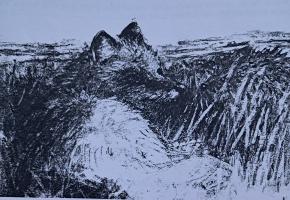Copy Link
Add to Bookmark
Report
dictyNews Volume 28 Number 13

dictyNews
Electronic Edition
Volume 28, number 13
May 18, 2007
Please submit abstracts of your papers as soon as they have been
accepted for publication by sending them to dicty@northwestern.edu
or by using the form at
http://dictybase.org/db/cgi-bin/dictyBase/abstract_submit.
Back issues of dictyNews, the Dicty Reference database and other
useful information is available at dictyBase - http://dictybase.org.
=========
Abstracts
=========
A CHS/Beige homologue is involved in biogenesis of Dictyostelium secretory
lysosomes
Steve J. Charette and Pierre Cosson
Universite de Geneve, Centre Medical Universitaire, Departement de
Physiologie Cellulaire et Metabolisme, 1 rue Michel Servet, CH-1211 Geneva 4,
Switzerland.
Journal of Cell Science, in press
The Chediak-Higashi syndrome (CHS) is characterized at the cellular level by
a defect in the ability of cells to secrete lysosomes. However the precise
step affected in the secretion process is unclear to date. This question was
addressed by characterizing Dictyostelium discoideum cells where LVSB, the
homologue of the CHS gene, was mutated. As observed in mammalian cells,
secretion of lysosome-derived compartments was affected in lvsB mutant cells.
This defect was mirrored by a decrease in the number of fusion-competent
post-lysosomal compartments, which in Dictyostelium can be clearly
distinguished from lysosomes. In addition, the transfer of endocytosed
particles from lysosomes to post-lysosomes was strongly diminished in lvsB
mutant cells compared to wild-type cells. These results suggest that LvsB is
primarily involved in transport from lysosomes to post-lysosomes, and thus
plays a critical role in the maturation of lysosomes into fusion-competent
post-lysosomal compartments.
Submitted by: Steve Charette [steve.charette@medecine.unige.ch]
--------------------------------------------------------------------------------
GrlJ, a Dictyostelium GABAB-like receptor with roles in post-aggregation
development
Yogikala Prabhu 1,4, Rolf Mueller 1, Christophe Anjard 3 and
Angelika A.Noegel 1,2*
1Institute of Biochemistry I, Centre for Biochemistry, Medical Faculty,
University of Cologne, Joseph-Stelzmann-Str. 52, D-50931 Kln, Germany
2Centre for Molecular Medicine Cologne, University of Cologne,
Joseph-Stelzmann-Str. 52, 50931 Kln, Germany
3Center for Molecular Genetics, Division of Biological Sciences, University
of California San Diego, La Jolla, CA 92093-0368, USA
4Present address: Cell Biology and Metabolism Branch, National Institute of
Child Health and Human Development, National Institutes of Health,
Bethesda, MD 20892, USA
BMC Developmental Biology, in press
Background: The G-protein-coupled receptor (GPCR) family represents the
largest and most important group of targets for chemotherapeutics. They are
extremely versatile receptors that transduce signals as diverse as biogenic
amines, purins, odorants, ions and pheromones from the extracellular
compartment to the interior via biochemical processes involving GTP-binding
proteins. Until recently, the cyclic AMP receptors (cARs) were the only known
G protein coupled receptors in Dictyostelium discoideum. The completed genome
sequence revealed the presence of several families of GPCRs in Dictyostelium,
among them members of the family 3 of GPCRs, the GABAB/ glutamate like
receptor family, which in higher eukaryotes is involved in neuronal signaling.
Results: D. discoideum has seventeen Family 3 members of GPCRs, denoted GrlA
through GrlR. Their transcripts are detected throughout development with
increased levels during early and late development. We have examined here
GrlJ. GFP-tagged GrlJ localises to the plasmamembrane and to internal
membranes. Inactivation of the grlJ gene leads to precocious development,
and the mutant completes development ~6 hours earlier. Alterations were also
noted at the slug stage and in spore formation. grlJ- slugs were longer
and broke apart several times on their way to culmination forming smaller
but proportionate fruiting bodies. Spores from grlJ- fruiting bodies were
malformed and less viable, although the spore differentiation factors were
synthesized and sensed normally. Expression of a GFP-tagged full length GrlJ
rescued the phenotype.
Conclusion: Our data suggest that GrlJ acts at several stages of
Dictyostelium development and that it is a negative regulator in Dictyostelium
development.
Submitted by: Angelika A.Noegel [noegel@uni-koeln.de]
--------------------------------------------------------------------------------
Possible roles of the endocytic cycle in cell motility
David Traynor and Robert R. Kay
J. Cell Sci., in press
Starving, highly motile Dictyostelium cells maintain an active endocytic
cycle, taking up their surface about every 11 minutes. Cell motility
depends on a functional NSF protein Ð also essential for endocytosis and
membrane trafficking generally Ð and we therefore investigated possible
ways in which the endocytic cycle might be required for cell movement.
First, NSF, and presumably membrane trafficking, are not required for the
initial polarization of the leading edge in a cyclic-AMP gradient. Second,
we can detect no evidence for membrane flow from the leading edge, as
photobleached or photoactivated marks in the plasma membrane move forward
roughly in step with the leading edge, rather than backwards from it. Third,
we find that the surface area of a cell Ð measured from confocal
reconstructions Ð constantly fluctuates during movement as the cell projects
pseudopodia and otherwise changes shape; increases of 20-30% can often occur
over a few minutes. These fluctuations cannot be explained by reciprocal
changes in filopodial surface area and they substantially exceed the 2 Ð3%
by which membranes can stretch. We propose that the endocytic cycle has a
key function in motility by allowing adjustment of cell surface area to
match changes in shape; and that without this function, movement is
severely impaired.
Submitted by: Rob Kay [rrk@mrc-lmb.cam.ac.uk]
--------------------------------------------------------------------------------
Locally controlled inhibitory mechanisms are involved in eukaryotic
GPCR-mediated chemosensing
Xuehua Xu1, Martin Meier-Schellersheim2, Jianshe Yan1 and Tian Jin1*
J. Biol. Chem., in press
GPCR signaling mediates a balance of excitatory and inhibitory
activities that regulate Dictyostelium chemosensing to cAMP. The
molecular nature and kinetics of these inhibitors are unknown. We report
that transient cAMP stimulations induce PIP3 responses without a
refractory period, suggesting that GPCR-mediated inhibition accumulates
and decays slowly. Moreover, exposure to cAMP gradients leads to
asymmetric distribution of the inhibitory components. The gradients
induce a stable accumulation of the PIP3 reporter PHCrac-GFP in the
front of cells near the cAMP source. Rapid withdrawal of the gradient
led to the re-association of G-protein subunits, and the return of the
PIP3 phosphatase PTEN and PHCrac-GFP to their pre-stimulus distribution.
Reapplication of cAMP stimulation produces a clear PHCrac-GFP
translocation to the back but not to the front, indicating that a
stronger inhibition is maintained in the front of a polarized cell. Our
study demonstrates a novel spatiotemporal feature of currently unknown
inhibitory mechanisms acting locally on the PI3K activation pathway.
Submitted by: Tian Jin [TJIN@niaid.nih.gov]
==============================================================
[End dictyNews, volume 28, number 13]






















